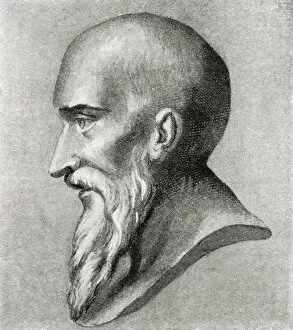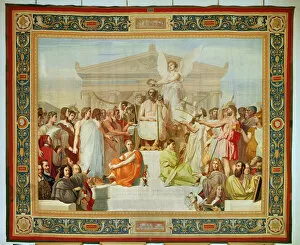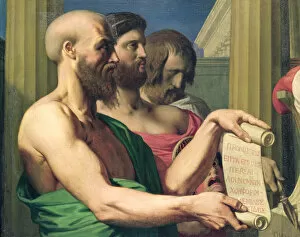Aeschylus Collection (page 2)
Aeschylus, the renowned Greek playwright of ancient times, continues to captivate us with his timeless works
All Professionally Made to Order for Quick Shipping
Aeschylus, the renowned Greek playwright of ancient times, continues to captivate us with his timeless works. Through the art of Red-figure pottery, we are transported into the world of his tragedies. A Krater portraying the Eumenides from one of Aeschylus's masterpieces reminds us of the intense emotions and conflicts that he skillfully portrayed on stage. In "Agamemnon, " performed at Bradfield College, we witness Clytemnestra standing at the Palace Door as Agamemnon approaches in his majestic chariot drawn by Trojan slaves. The tension between them is palpable, foreshadowing a tragic fate awaiting both characters. Another powerful image depicts Apollo defending Oreste from the relentless Fury who relentlessly pursues him. This scene showcases Aeschylus's ability to intertwine divine intervention with human struggles, creating a captivating narrative that resonates through time. The Death depicted in The Florentine Picture-Chronicle serves as a reminder of his legacy and contributions to literature. Created using pen, ink & wash on paper, this artwork immortalizes an influential figure whose impact can still be felt today. Amongst these depictions lies "The Triumph of Truth, " an oil painting from the 19th century that symbolizes Aeschylus's commitment to exploring profound truths within his plays. Its detailed brushwork invites viewers to reflect upon their own understanding and pursuit of truth. "The Furies Departing" captures Athena, Apollo, and Orestes bidding farewell to these vengeful spirits after their tumultuous journey together. Rendered in pen & ink on paper during the 18th century, this drawing encapsulates both relief and resolution found within Aeschylus's narratives. Engravings such as those depicting performances at Cambridge University or showcasing Venus from "The Supplicants" pay homage to how Aeschylus's work has been celebrated and interpreted across generations.













